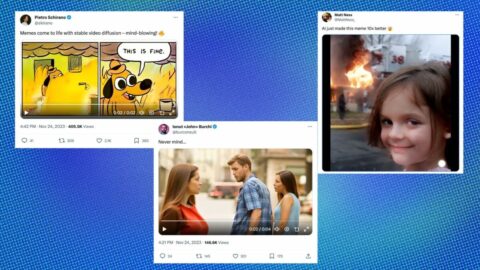
Using AI to turn memes into GIFs is now a thing, which is possibly the most mindfuck phrase you’ll read today.
Thanks to Stable Video Diffusion (SVD), and other AI video tools, memes — a snapshot of reality pulled out of context — are further removed from reality by AI’s interpretation of events.
What is SVD and what can it do?
Last week, Stability AI released Stable Video Diffusion, an image-to-video foundation model. Based on its AI image generation model, SVD can turn images into short animated clips. Naturally, the internet’s first three was to apply SVD to memes. The end result is an AI-generated-meme-turned-GIF effectively splintering viral content into its own AI-driven multiverse.
Before Stability AI released Stable Video Diffusion, there were already generative AI video tools out there. Runway has text-to-video and video-to-video tools, but its free options are limited, and you have to sign up for a paid subscription to access more tools and credits. There’s also Pika, an AI video-editing platform that launched on Tuesday with a waitlist to sign up. But Stability AI’s Stable Video Diffusion is free to use and open-source accessible through its GitHub repository.
Users are having fun bringing their favorite memes to life, while simultaneously making us question reality. Here’s a roundup of the more successful ones made with SVD or other tools like Runway.
1. Everyone’s favorite in-denial meme is so much more visceral
2. Somehow the disaster girl meme becomes even more sinister
3. The Ugandan child side-eye meme really comes to life
4. The girl from the distracted boyfriend meme finally gets to react (and also gets a cardigan along the way)
5. You could capture a clip from the original Willy Wonka and the Chocolate Factory film, or you could use AI to animate the still
6. Plus, Stable Video Diffusion preserves text, taking meme animation to the next level
Stability AI explicitly states that use of its SVD model can only be used for research purposes and not for commercial applications, which protects video generation using existing content from the increasingly murky issue of AI and copyright infringement laws.
Topics
Artificial Intelligence
Memes
